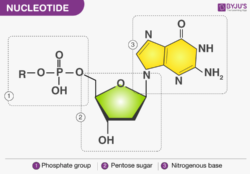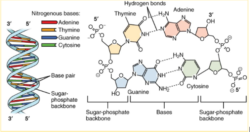According to the CBSE Syllabus 2023-24, this chapter has been renumbered as Chapter 5.
What Is DNA?
DNA- Deoxyribonucleic Acid is considered the molecule of inheritance as it carries genetic information in all living organisms. It is a long polymer chain of deoxyribonucleotides. Its length depends on the number of nucleotide base pairs present in it.
Watson and Crick were the first scientists who proposed a double-helical model for DNA based on X-ray crystallography of the molecule. Each strand of DNA is a polymer of nucleotides, every nucleotide consists of a deoxyribose sugar, a nitrogen base and a phosphate.
According to the central dogma of molecular biology, genetic information flows from DNA to RNA to protein.
The complete DNA structure looks like a twisted ladder. The two strands of DNA are held together by weak hydrogen bonds between the nitrogen bases. A purine base always pairs with a pyrimidine base, i.e., adenine (A) pairs with thymine (T) and guanine (G) pairs with cytosine (C).
Students can refer to the short notes and MCQ questions along with separate solution pdf of this chapter for quick revision from the links below:
- Molecular Basis of Inheritance Study Notes
- Molecular Basis of Inheritance MCQ Practice Questions
- Molecular Basis of Inheritance MCQ Practice Solutions
Structure of Polynucleotide

A nucleotide consists of three elements – a nitrogenous base, sugar and a phosphate group. Nitrogenous bases are in the form of purines(Adenine, Guanine) and Pyrimidines(Cytosine and Thymine). The sugar part is constituted by the pentose sugar(ribose in RNA and deoxyribose in DNA), while the phosphate group is constituted by the nucleoside and nucleotide.

See Also: Important Questions for Class 12 Chapter 6: Molecular Basis of Inheritance
What Is a Gene?
A gene is the functional unit of inheritance. In all eukaryotic organisms, DNA consists of both coding and non-coding sequences of nucleotides. The coding sequences are defined as exons, and non-coding sequences are defined as introns. These exons appear in the matured RNA, but the introns do not appear.
RNA- Ribonucleic Acid. It is a single strand of nucleic acid present in all living cells and acts as a messenger carrying instructions from DNA for controlling protein synthesis. The three primary types of RNA molecules are,
- Messenger RNA (mRNA)
- Transfer RNA (tRNA)
- Ribosomal RNA (rRNA)
Packaging DNA Helix
- DNA in prokaryotes is arranged as a large loop in the nucleoid region wherein the negatively charged DNA is firmly held by positively charged proteins.
- DNA in prokaryotes is observed as a complex organisation of DNA in chromosomes. DNA is wound around the core of histone octamer (a unit with 8 histone molecules) to form a nucleosome.
- Positively charged proteins in the form of histones are observed that are rich in basic amino acids, lysine and arginine. They are of 5 types – H1, H2A, H2B, H3 and H4. The histone octamer has 2 molecules of 4 histone proteins vital in gene regulation.
- Nucleosome is a repeating unit in the chromatin preventing DNA from tangling containing nearly 200 bp of DNA.
- The further packaging of chromatin is facilitated by NHC (Non-histone chromosomal proteins).
- Euchromatin: transcriptionally active areas, wherein chromatin is loosely packed and they take up the light stain.
- Heterochromatin: transcriptionally inactive areas, wherein chromatin is densely packed and takes up the dark stain.
RNA World
RNA was the first genetic material, and supporting this is enough evidence suggesting vital life processes evolved around RNA. It is used to act as a genetic material and a catalyst as well. But as a catalyst, RNA was very reactive and, therefore, unstable. Hence, DNA evolved from RNA with chemical alterations making it more stable.
Replication
- Watson and Crick proposed that DNA replication is semiconservative.
- Meselson and Stahl, in 1958, proved experimentally that DNA replicates semi conservatively.
- Taylor et al., in another experiment on faba beans (Vicia faba) using radioactive thymidine, proved that the replication of DNA is semiconservative.
- Enzyme DNA polymerase catalyses DNA replication. It can polymerise only in 5’→3’ direction.
- Replication is continuous in a strand with 5’→3’ direction, called the leading strand, where the template strand has 3’→5’ polarity, called the leading strand template.
- Replication is discontinuous in a lagging strand template where the template strand has 5’→3’ polarity.
Transcription
The genetic information present in DNA (one segment only) is copied into RNA. Adenine pairs with Uracil instead of Thymine in RNA. Transcription of DNA involves three regions – the structural gene, promoter, and terminator. The RNA polymerase catalyses transcription, while the direction of transcription is the same as that of replication by DNA polymerase, i.e. 5’→3’ direction. The template strand has a 3’→5’ polarity acting as a template for RNA formation, known as an antisense strand. The coding strand has a 5’→3’ polarity and is also known as a sense strand. In addition, it consists of the structural gene, promoter, terminator, exons and introns.
Genetic Code
These are the sequences of bases in mRNA coding for a specific amino acid in the synthesis of proteins. Here every code is composed of three nucleotides known as triplets. Totally, there are 64 codons, where 61 code for amino acids. The rest 3 are known as stop codons, as they do not code for any amino acid. AUG is the start codon and codes for the amino acid methionine as well.
Mutations and Genetic Code
A change in the single base pair causes point mutation. Example – sickle cell anaemia in the gene coding for the 𝛽-globin chain. As a result, Glutamate in the normal protein gets converted to Valine in the sickle cell. The reading frame at the point of deletion or insertion is changed when there is a loss or gain of one or two base pairs. This is known as frameshift mutation.
Translation
It is the process of amino acid polymerisation. Amino acids are joined by peptide bonds. All three RNAs(mRNA, tRNA and rRNA) have a different role in the process of translation. The first stage in this process of translation is the aminoacylation of tRNA. Ribosomes are a protein manufacturing factory, acting as a catalyst in the formation of a peptide bond. The translation process is in the 5’→3’ direction always. There are two sites in the large subunit of a ribosome accommodating two tRNAs with amino acids close enough to form a peptide bond.
Regulation of Gene Expression
- The expression of a gene to form polypeptides can be regulated at different levels in eukaryotes.
- At the time of formation of a primary transcript, i.e. transcription,
- At the time of processing or splicing,
- At the time of transportation of mRNA from the nucleus to the cytosol, and
- At the time of protein synthesis, i.e., translation.
- Gene expression is regulated by environmental, physiological and metabolic conditions.
- The development and differentiation of an embryo is a result of coordinated regulation and expression of several sets of genes.
- Control of gene expression in prokaryotes is mainly at the initiation of transcription.
- The activity of RNA polymerase at the start site is regulated by regulatory proteins, which can be a repressor or activator.
- The accessibility of the promoter region is regulated by an operator sequence adjacent to it that binds with the specific protein, mostly a repressor. There is a specific operator and repressor protein in a specific operator.
Read More: DNA Fingerprinting
For more information on Heredity and Recombinant DNA Technology, watch the below videos


A Few Important Questions
- What is Polymorphism?
- What is DNA fingerprinting?
- List out the functions of the Promoter.
- Differentiate between mRNA and tRNA.
- List out the goals of the Human Genome Project.
Learn more about heredity, the Law of Inheritance, chromosomes and genes from the topics given below:
| Chromosomes | Principles of Genetics |
| Mendel’s Laws of Inheritance | Chromosomal Theory of Inheritance |
Frequently Asked Questions on CBSE Class 12 Biology Notes Chapter 6 Molecular Basis of Inheritance
What are the uses of polynucleotide?
Polynucleotides are used in biochemical experiments such as polymerase chain reaction (PCR) or DNA sequencing.
What is a DNA Helix?
A double helix is the description of the structure of a DNA molecule. A DNA molecule consists of two strands that wind around each other like a twisted ladder.
What is gene expression regulation?
Regulation of gene expression, or gene regulation, includes a wide range of mechanisms that are used by cells to increase or decrease the production of specific gene products (protein or RNA).

Comments